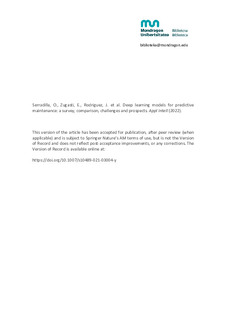| dc.contributor.author | Serradilla, Oscar | |
| dc.contributor.author | Zugasti, Ekhi | |
| dc.contributor.author | Zurutuza, Urko | |
| dc.contributor.other | Rodríguez Breton, Jon | |
| dc.date.accessioned | 2022-02-17T10:25:28Z | |
| dc.date.available | 2022-02-17T10:25:28Z | |
| dc.date.issued | 2022 | |
| dc.identifier.issn | 1573-7497 | en |
| dc.identifier.other | https://katalogoa.mondragon.edu/janium-bin/janium_login_opac.pl?find&ficha_no=167015 | en |
| dc.identifier.uri | https://hdl.handle.net/20.500.11984/5473 | |
| dc.description.abstract | Given the growing amount of industrial data in the 4th industrial revolution, deep learning solutions have become popular for predictive maintenance (PdM) tasks, which involve monitoring assets to anticipate their requirements and optimise maintenance tasks. However, given the large variety of such tasks in the literature, choosing the most suitable architecture for each use case is difficult. This work aims to facilitate this task by reviewing various state-of-the-art deep learning (DL) architectures and analysing how well they integrate with predictive maintenance stages to meet industrial companies’ requirements from a PdM perspective. This review includes a self-organising map (SOM), one-class neural network (OCNN) and generative techniques. This article explains how to adapt DL architectures to facilitate data variability handling, model adaptability and ensemble learning, all of which are characteristics relevant to industrial requirements. In addition, this review compares the results of state-of-the-art DL architectures on a publicly available dataset to facilitate reproducibility and replicability, enabling comparisons. Furthermore, this work covers the mitigation step with deep learning models, the final PdM stage that is essential for implementing PdM systems. Moreover, state-of-the-art deep learning architectures are categorised, analysed and compared; their industrial applications are presented; and an explanation of how to combine different architectures in a solution is presented that addresses their gaps. Finally, open challenges and possible future research paths are presented and supported in this review, and current research trends are identified. | en |
| dc.description.sponsorship | Comisión Europea | es |
| dc.description.sponsorship | Diputación Foral de Gipuzkoa | es |
| dc.language.iso | eng | en |
| dc.publisher | Springer Science+Business Media, LLC | en |
| dc.rights | © The Author(s), under exclusive licence to Springer Science+Business Media, LLC | en |
| dc.subject | Keywords Deep learning | en |
| dc.subject | predictive maintenance | en |
| dc.title | Deep learning models for predictive maintenance: a survey, comparison, challenges and prospects | en |
| dcterms.accessRights | http://purl.org/coar/access_right/c_f1cf | en |
| dcterms.source | Applied intelligence | en |
| local.contributor.group | Análisis de datos y ciberseguridad | es |
| local.description.peerreviewed | true | en |
| local.identifier.doi | https://doi.org/10.1007/s10489-021-03004-y | en |
| local.relation.projectID | info:eu-repo/grantAgreement/EC/H2020/825030/EU/Digital Reality in Zero Defect Manufacturing/QU4LITY | en |
| local.relation.projectID | info:eu-repo/grantAgreement/DFG/Programa de Red Guipuzcoana de Ciencia, Tecnología e Innovación 2020/OF-326-2020/GIP/Hacia una metodología que guíe a la industria al mantenimiento predictivo y explicativo/MEANER | en |
| local.embargo.enddate | 2023-01-31 | |
| local.contributor.otherinstitution | Koniker, S. Coop. | es |
| local.source.details | 2022 | en |
| oaire.format.mimetype | application/pdf | |
| oaire.file | $DSPACE\assetstore | |
| oaire.resourceType | http://purl.org/coar/resource_type/c_6501 | en |
| oaire.version | http://purl.org/coar/version/c_ab4af688f83e57aa | en |







